-
Paper Information
- Paper Submission
-
Journal Information
- About This Journal
- Editorial Board
- Current Issue
- Archive
- Author Guidelines
- Contact Us
Applied Mathematics
p-ISSN: 2163-1409 e-ISSN: 2163-1425
2022; 12(1): 17-24
doi:10.5923/j.am.20221201.03
Received: Mar. 1, 2022; Accepted: Mar. 16, 2022; Published: Apr. 15, 2022

Numerical Study for Three Lane Traffic Flow Model
Md. Shajib Ali
Dept. of Mathematics, Islamic University, Kushtia, Bangladesh
Correspondence to: Md. Shajib Ali, Dept. of Mathematics, Islamic University, Kushtia, Bangladesh.
| Email: |  |
Copyright © 2022 The Author(s). Published by Scientific & Academic Publishing.
This work is licensed under the Creative Commons Attribution International License (CC BY).
http://creativecommons.org/licenses/by/4.0/

In this article we study two numerical solutions of first order explicit upwind difference scheme (EUDS) and second order Lax-Wendroff difference scheme (LWDS) for a system of first order non-linear PDEs. The numerical simulation of a 10 km highway of three lanes is performed for 6 minutes using both the numerical schemes based on artificial initial and boundary data. The computed simulation result satisfies some verified qualitative figures of numerical solution and also the numerical solution converges for smaller temporal and spatial grid sizes.
Keywords: Three lane traffic flow model, First order system of non-linear PDE, Numerical simulation
Cite this paper: Md. Shajib Ali, Numerical Study for Three Lane Traffic Flow Model, Applied Mathematics, Vol. 12 No. 1, 2022, pp. 17-24. doi: 10.5923/j.am.20221201.03.
Article Outline
1. Introduction
- Transportation is important for human being activity as the economy grows. Under rapid growing economy, it always happens negative impact by growing transportation because of transportation demand versus infrastructure development such as road construction, traffic control management system, public transportation implementation, and so on. Negative impact occurs as traffic congestion, traffic accident, unnecessity fuel consumption, environment destruction, air pollution, noise pollution, traffic fatality as transportation issues in general. There is no exception but this transportation issue in the world, not only developing countries but also advanced countries. Therefore it is important to understand traffic flow condition and mechanism of traffic congestion reason at least. After collecting traffic data and analysis, it digs into traffic flow problem and shows important traffic flow parameter for traffic congestion with using actual traffic measurement data in major cities. Traffic models can be used for several applications, and much attention has been given to research on traffic models. The traffic flow model first developed by Lighthill and Whitham (1955) and Richard (1956)] shortly is known as LWR model [1-3]. In [5-9] describe finite difference scheme for a fluid dynamic traffic flow model. The basic features of the LWR model prescribe in Klar [2], Habermann (1977) [4]. Additions are made after the development of these traffic models and other models have been developed. There are different types of traffic flow models and they can be classified in various ways. A good number of numerical solutions for macroscopic multilane traffic flow models are found in literature [10-15]. Thus, the main objective of this paper three lane traffic model approximated a linear velocity-density relationship which is system of first order hyperbolic partial differential equation with unknown variable density. It is impossible to find the exact solution of the multilane traffic model. So, there is a demand to find the numerical solution of considered traffic model and present the descretization which leads to the first order explicit upwind difference scheme (EUDS) and also second order Lax-Wendroff difference scheme (LWDS). The numerical simulation of 10 km highway of three lane is performed for 6 minutes using both the numerical schemes based on artificially generated initial and boundary data. Finally, we verify some experimental results for both schemes. The stability conditions of EUDS and LWDS for considered model are 0.0668 and 0.5171 respectively. Three lane mathematical model of traffic flow in section 2. In section 3-4, numerical solution of first and second order and section 5 performing computed numerical experiments and finally we conclusions.
2. Mathematical Equation of Three Lane Traffic Flow Model
- Consider multilane traffic flow model for three lanes
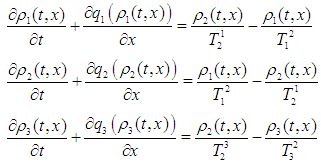 | (1) |
 as a function of density and flux
as a function of density and flux  and Greenschield’s linear density-velocity relation is
and Greenschield’s linear density-velocity relation is  where
where  is maximum velocity and
is maximum velocity and  is maximum density. Therefore, the flux
is maximum density. Therefore, the flux 

3. First Order EUDS for Three Lane Traffic Flow Model
- The first order system of non-linear partial differential equation for three lane traffic flow model as follows:
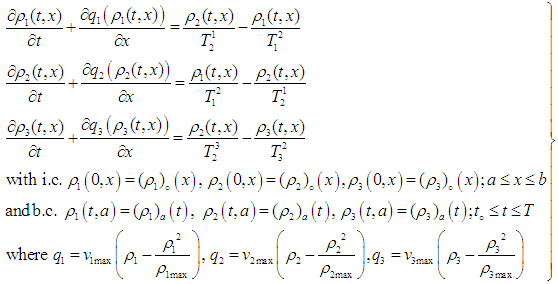 | (2) |
 | (3) |
 | (4) |
 | (5) |
 So, equations (3), (4) and (5) are the explicit upwind difference scheme for the IBVP (2).The well-posed-ness and stability condition of EUDS [8] is guaranteed by the simultaneous conditions
So, equations (3), (4) and (5) are the explicit upwind difference scheme for the IBVP (2).The well-posed-ness and stability condition of EUDS [8] is guaranteed by the simultaneous conditions  and
and  In case of three lane traffic flow model are also remain unchanged for our considered model of above condition.
In case of three lane traffic flow model are also remain unchanged for our considered model of above condition. 4. Second Order LWDS for Three Lane Traffic Flow Model
- The numerical solution of second order Lax-Wendroff difference scheme as an IBVP with two sided boundary conditions reads as follows:
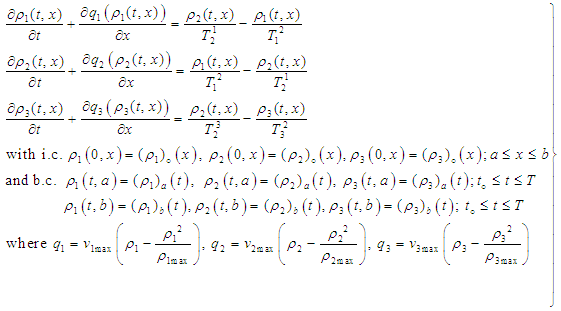 | (6) |
 , by Cauchy-Kawalewski technique. Then the Lax-Wendroff difference scheme [14] of the first order non-linear PDE (6) takes the form
, by Cauchy-Kawalewski technique. Then the Lax-Wendroff difference scheme [14] of the first order non-linear PDE (6) takes the form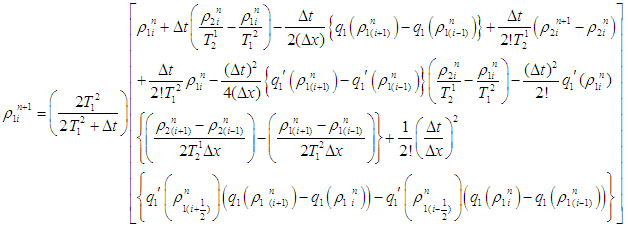 | (7) |
 | (8) |
 | (9) |
 and
and 
 Equations (7), (8) and (9) are the Lax-Wendroff schemes for the IBVP (6).The well-posed-ness and physical constraint conditions of Lax-Wendroff difference difference scheme [9] is guaranteed by the simultaneous conditions
Equations (7), (8) and (9) are the Lax-Wendroff schemes for the IBVP (6).The well-posed-ness and physical constraint conditions of Lax-Wendroff difference difference scheme [9] is guaranteed by the simultaneous conditions  and
and  and also remain unchanged for our considered three lane traffic flow model.
and also remain unchanged for our considered three lane traffic flow model.5. Numerical Results and Discussion
- In this section, we implement the numerical schemes of first order EUDS and second order LWDS and also present the outcome of traffic flow simulation for a variety of traffic flow parameters. Here, we choose maximum velocity
 ,
,  and
and  of three lanes respectively. For satisfying the CFL condition we pick the unit of velocity as km/sec and choose maximum density
of three lanes respectively. For satisfying the CFL condition we pick the unit of velocity as km/sec and choose maximum density 

 and perform the numerical experiment for 6 minutes. We consider the different initial density of multilane traffic flow model for three lanes are
and perform the numerical experiment for 6 minutes. We consider the different initial density of multilane traffic flow model for three lanes are  . The transition rate from the second lane to the first lane 20%, the first lane to the second lane 10%, the second lane to the third lane 20% and the third lane to the second lane 10%. We implement of above artificial initial and boundary data of three lane traffic flow model of EUDS and LWDS. Also we verify the well-known qualitative behaviors of different traffic flow variables of multilane traffic flow model for three lanes. We run the program and attain the initial density profiles as shown in figure 1.
. The transition rate from the second lane to the first lane 20%, the first lane to the second lane 10%, the second lane to the third lane 20% and the third lane to the second lane 10%. We implement of above artificial initial and boundary data of three lane traffic flow model of EUDS and LWDS. Also we verify the well-known qualitative behaviors of different traffic flow variables of multilane traffic flow model for three lanes. We run the program and attain the initial density profiles as shown in figure 1. 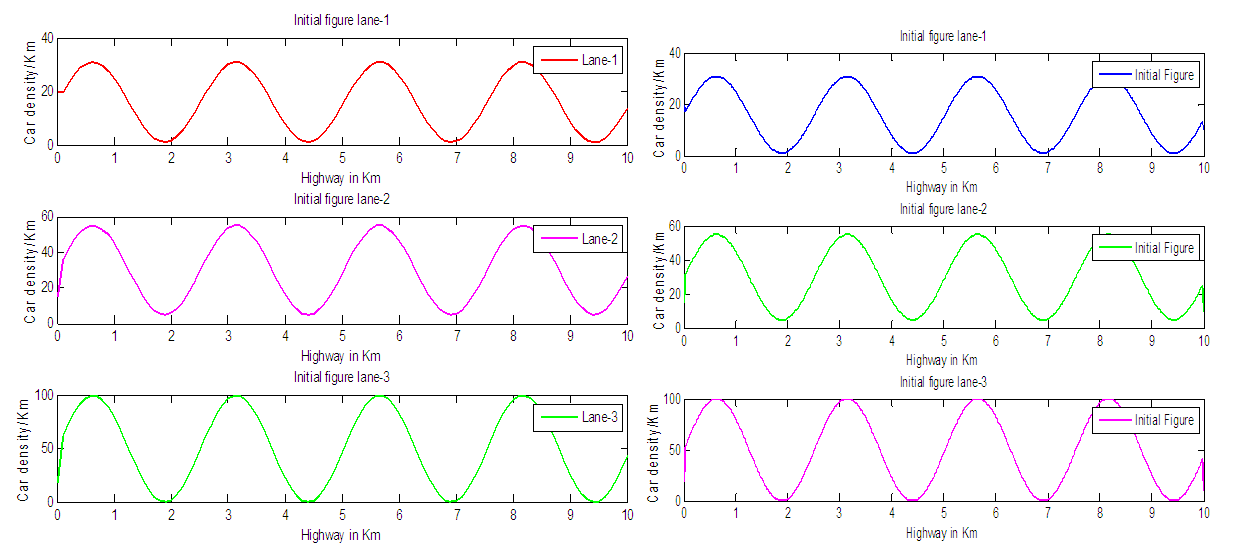 | Figure 1. Initial density profile of EUDS and LWDS |
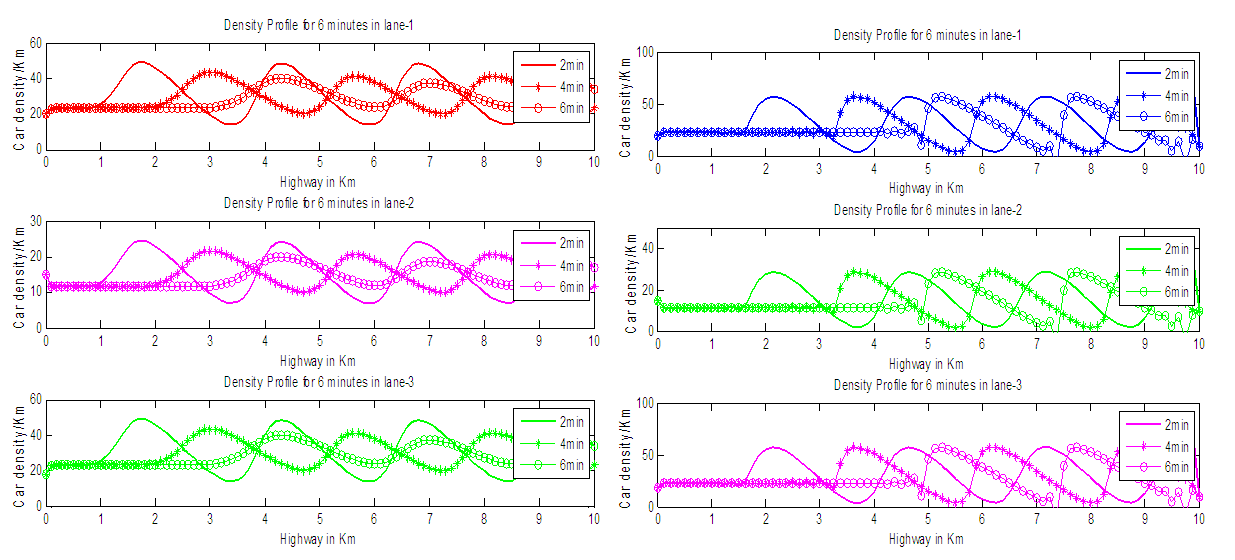 | Figure 2. Density profile of EUDS and LWDS |
 | Figure 3. Computed velocity profile using EUDS and LWDS |
 Figure 4 represents the computed flux with respect to the distance for 6 minutes. Here we observe that, as time goes on, the traffic wave is moving forward.
Figure 4 represents the computed flux with respect to the distance for 6 minutes. Here we observe that, as time goes on, the traffic wave is moving forward. | Figure 4. Flux profile of EUDS and LWDS |
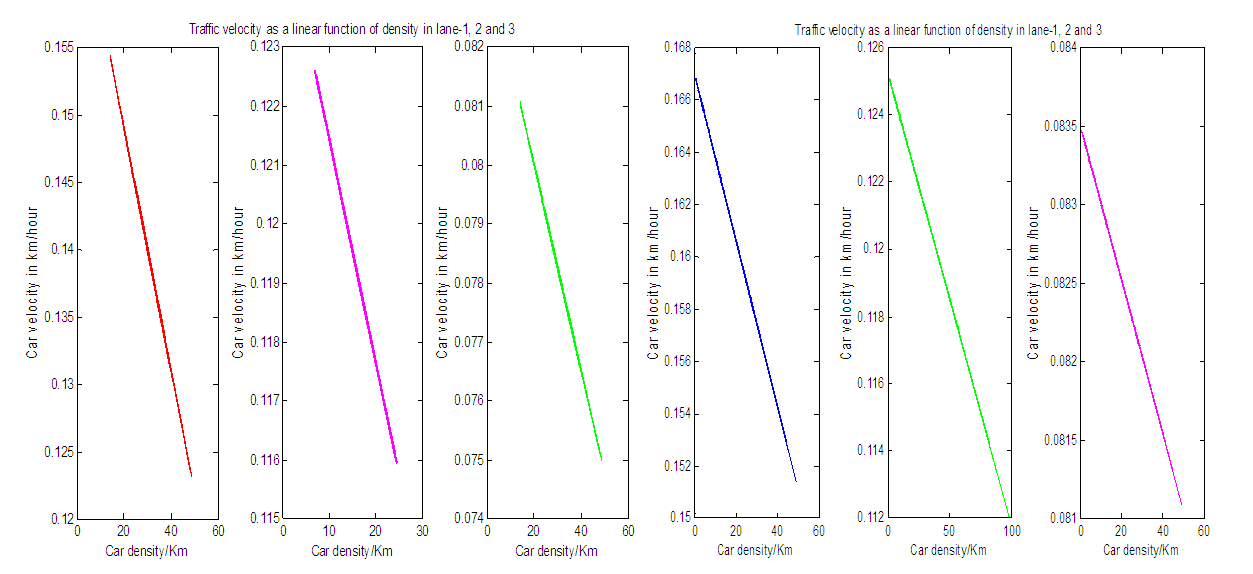 | Figure 5. Traffic velocity as a linear function of density in case of EUDS and LWDS |
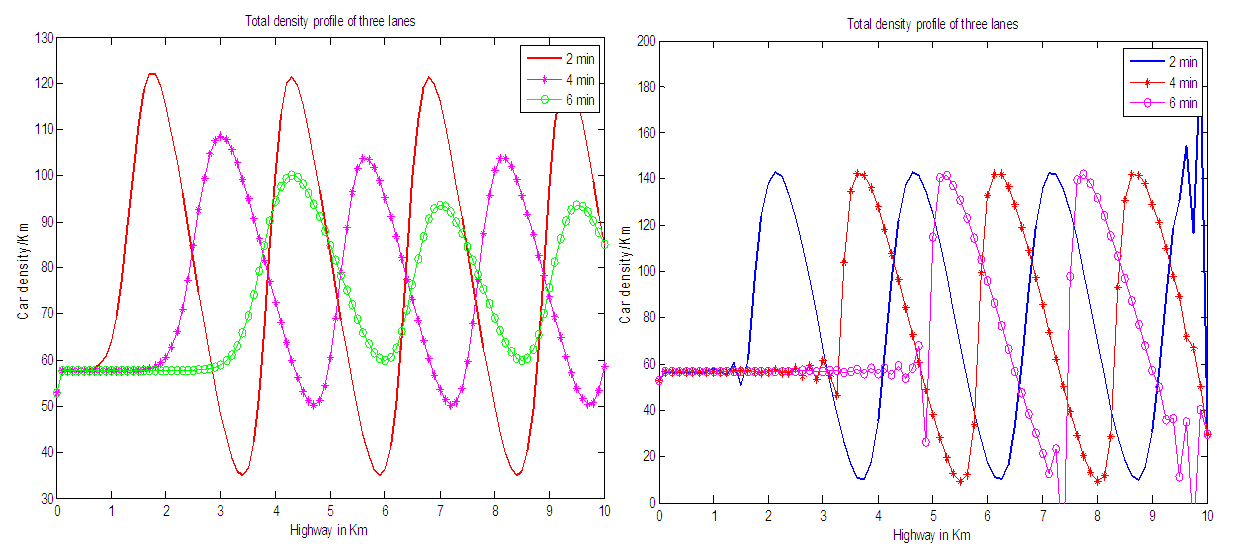 | Figure 6. Total density profile of three lanes in case of EUDS and LWDS |
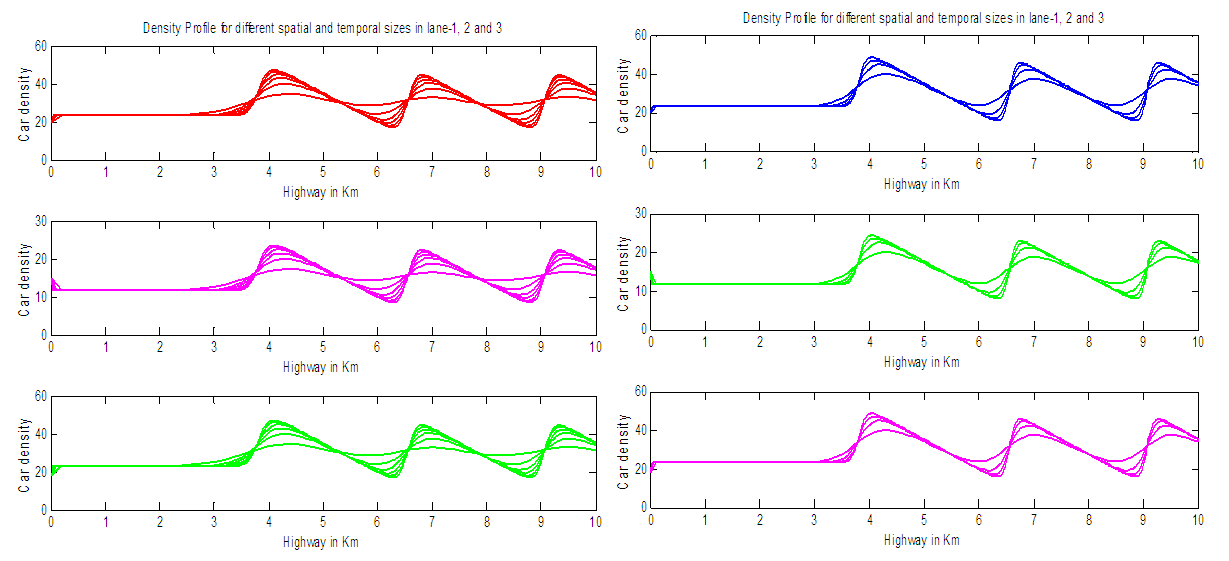 | Figure 7. Density Profile for different spatial and temporal step sizes using EUDS and LWDS |
6. Conclusions
- We have shown that the numerical result based on the explicit finite difference scheme and Lax-Wendroff difference scheme agrees with basic some qualitative behavior of multilane traffic flow model for three lanes. This qualitative behavior agreement verified the implementation of numerical schemes for the multilane traffic flow model with sufficient accuracy. Also we present that the sum of the flow of three lanes is in same nature as the flow of the single lane traffic flow model. Finally we have shown that the numerical solution converges for decreasing temporal and spatial grid sizes where the rate of convergence of LWDS is higher than EUDS.
 Abstract
Abstract Reference
Reference Full-Text PDF
Full-Text PDF Full-text HTML
Full-text HTML